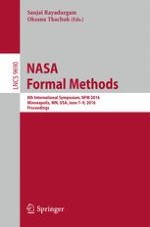This book constitutes the proceedings of the 8th International Symposium on NASA Formal Methods, NFM 2016, held in Minneapolis, MN, USA, in June 2016.
The 19 full and 10 short papers presented in this volume were carefully reviewed and selected from 70 submissions. The papers were organized in topical sections named: requirements and architectures; testing and run-time enforcement; theorem proving and proofs; application of formal methods; code generation and synthesis; model checking and verification; and correctness and certification.
